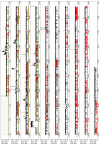Deep short-read sequencing of chromosome 17 from the mouse strains A/J and CAST/Ei identifies significant germline variation and candidate genes that regulate liver triglyceride levels
- PMID: 19825173
- PMCID: PMC2784327
- DOI: 10.1186/gb-2009-10-10-r112
Deep short-read sequencing of chromosome 17 from the mouse strains A/J and CAST/Ei identifies significant germline variation and candidate genes that regulate liver triglyceride levels
Abstract
Genome sequences are essential tools for comparative and mutational analyses. Here we present the short read sequence of mouse chromosome 17 from the Mus musculus domesticus derived strain A/J, and the Mus musculus castaneus derived strain CAST/Ei. We describe approaches for the accurate identification of nucleotide and structural variation in the genomes of vertebrate experimental organisms, and show how these techniques can be applied to help prioritize candidate genes within quantitative trait loci.
Figures








References
-
- Paigen K. Understanding the human condition: experimental strategies in mammalian genetics. ILAR J. 2002;43:123–135. - PubMed
Publication types
MeSH terms
Substances
Grants and funding
LinkOut - more resources
Full Text Sources
Miscellaneous

